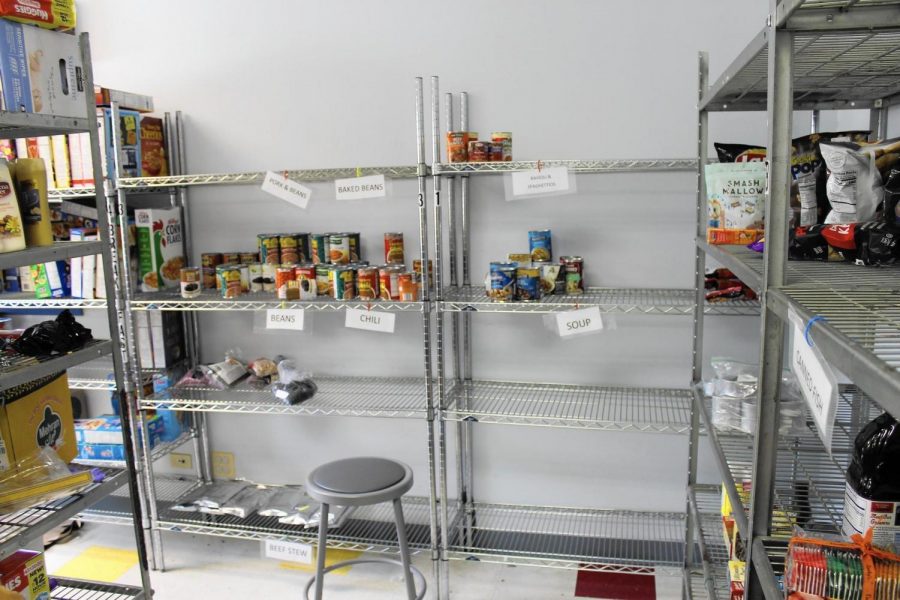Donate Cash to Food Pantries, Not Old Soup Cans
This Easter season, consider donating money to food pantries, such as the Niles Township Food Pantry above, rather than canned goods.
Mar 13, 2018
Walgreens and Targets exploding in pastel is a mark that spring and Easter are almost here, and charities start entering the forefront. Whether it’s celebrities on TV reminding you to donate or canned food drives popping up left and right, the spirit of giving is everywhere. The food drives are something most people have done or seen, at the workplace, outside grocery stores, at schools, at churches, synagogues, temples, maybe in an apartment building. Canned food drives are everywhere during holidays, but how effective are they?
In the view of those who work for these charities, not very. Economically speaking, it’s just not wise. According to the Greater Chicago Food Depository, one dollar can buy three meals for a family in need, while a dollar to a regular person can buy… a pack of gum? Food pantries rather, can buy fresh food, directly from farms, and buy in bulk.
Katherina Rosqueta, the executive director of the Center for High Impact Philanthropy told Slate’s Matthew Yglesias that charities on average can get a pound of food for ten cents that would normally cost two dollars to the average person. From an economic standpoint, your dollar is worth a lot more donated directly to the charity rather than buying food for them.
The food that’s given in a food drive doesn’t tend to be the highest quality either. Greg Bloom, director of Bread for the City, told Slate “we find that almost half of what comes to us in any given food drive just doesn’t meet our nutritional standards.” Food drives are frequently used as a way to clear the pantry of old food, typically pasta and soup, but soup still has an expiration date, and if it has already been sitting in the pantry for months, it might be expired by the time it reaches the hungry.
Canned soup is also very high in sodium, which means if it’s given to someone who can’t afford food, but has health issues, they might not even be able to eat it. Rosqueta estimates 50% of food actually ends up going uneaten after delivery due to health issues.
Soups and pasta are some of the foods that people expect you to donate, but the pantries themselves don’t. Non-perishables are good to donate as they don’t go bad quickly, but pantries typically have a list on their website of foods that they would prefer you donate. This includes cereal, peanut butter, and baby food, not pasta and soup alone.
The people who depend on food drives probably would like to eat the same foods as everyone else. The idea that the hungry should be grateful for whatever their given is dehumanizing and adds increasing stigma on the poor. Giving money, however, can give the people fresh food that can be very important to their health. Everyone deserves a healthy, nutritious meal, not just people who can afford them.
The strain put on the local food bank is also important to note. Once the food is locally collected it’s delivered to the food banks and has to be sorted and inspected, which is a lot of work on the charity. Anthony Araque, the manager of the Niles Food Pantry, gave the details.
“We served 500,000 pounds of food in 2015, and it took four full time employees and an average of 20 volunteers a month,” Araque said.
This manual labor could be cut down if workers were just buying the food themselves, which would not require hours of sorting and quality checking. Of course, food drives don’t have the intent of causing work pile ups at the local food pantry, but that is the result.
Donating food directly can give people the security of knowing it can’t be misused, like money can. There hasn’t been a shortage of non-profit organizations being exposed for misappropriation of funds, and citizens can be concerned about their money not being used for food. Rosqueta addressed this during an interview for NPR, and said that most food banks have a bank account specifically for buying food, and the donated money in the account will go towards nothing else.
An issue with pulling away from food drives is the likelihood of donation. Andrew Johnson, sponsor of the Niles West WHO Club, a volunteering club, gave a simple explanation.
“I think for some people, that concrete idea of actually giving something from their home is significant. They may be more likely to give that way, it means more to them,” Johnson said.
Giving physical food will make the donor know for sure that it will be used, and it feels more tangible. For kids and teenagers, giving food means you don’t have to spend money, and can just take something from home, so they may be more likely to donate this way. Money is a very valuable resource for kids and teens, and again, they feel they have no clue as to what it will be used for, and therefore will be less likely to donate it.
Now, more donations are good, but how much of that old food kids take from their cupboard will actually be used? 50% will be sorted out by the food banks, then another 25% probably won’t be eaten by the family, so only 25% of these donations will actually end up in the mouths of the hungry, and that isn’t a good enough percentage. People might be less likely to donate money, but it is exponentially more valuable to the food banks to do so. So, during this spring season, please eat your own soup, and please give your cash to the people who can spend it the best: your local food bank.




